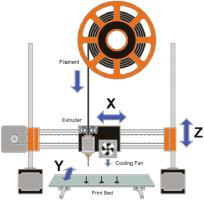Talanta Open ( IF 4.1 ) Pub Date : 2021-06-24 , DOI: 10.1016/j.talo.2021.100051 Matthew J. Whittingham , Robert D. Crapnell , Emma J. Rothwell , Nicholas J. Hurst , Craig E Banks

|
Additive Manufacturing (AM) is an ever-growing part of modern scientific research due to its ability to create complex features, low wastage, ever-decreasing cost of entry and rapid prototyping capabilities. Up to this point, the use of AM in electrochemical research has focused around two of the main components of the experimental setup: the working electrode, and the electrochemical cell. In this paper we highlight how researchers have utilised AM in the literature and offer our own insights into how this technology can be exploited to benefit all areas of electrochemical research. For the development of electrodes, much of the literature utilises commercially available conductive PLA filaments in conjunction with FFF printing, with only a few groups expanding into the development of their own bespoke conductive materials.
AM offers huge advantages in the production of electrochemical cells, allowing users to produce bespoke designs to fit their experimental needs, rapidly producing these at low cost and easily modifying the design to improve performance. However, the use of AM in electrochemical laboratories should not stop there. We present basic designs of electrodes, cells and even accessories that can benefit all electrochemical researchers (new and experienced) in their quest for reproducible and reliable results. These designs are offered free of charge, are available to download from the Supporting Information and can be easily modified to meet any users’ specific needs. As such, we feel AM should be a staple of every laboratory and hope this work inspires people to think about all the ways that AM can benefit their research environments.
中文翻译:

电化学实验室的增材制造:关于电池、电极和配件生产的概述和教程说明
增材制造 (AM) 是现代科学研究的一个不断增长的部分,因为它能够创建复杂的特征、低浪费、不断降低的进入成本和快速原型制作能力。到目前为止,AM 在电化学研究中的使用主要围绕实验装置的两个主要组成部分:工作电极和电化学电池。在本文中,我们重点介绍了研究人员如何在文献中利用 AM,并就如何利用该技术使电化学研究的所有领域受益提供我们自己的见解。对于电极的开发,大部分文献都将市售的导电 PLA 细丝与 FFF 印刷结合使用,只有少数团体扩展到开发自己的定制导电材料。
AM 在电化学电池的生产中具有巨大的优势,允许用户生产定制设计以满足他们的实验需求,以低成本快速生产这些,并轻松修改设计以提高性能。然而,在电化学实验室中使用 AM 不应就此止步。我们展示了电极、电池甚至附件的基本设计,这些设计可以使所有电化学研究人员(新手和老手)在寻求可重复和可靠的结果时受益。这些设计是免费提供的,可从支持信息下载,并可轻松修改以满足任何用户的特定需求。因此,我们认为 AM 应该成为每个实验室的主要内容,并希望这项工作能激发人们思考 AM 可以使他们的研究环境受益的所有方式。











































 京公网安备 11010802027423号
京公网安备 11010802027423号